With的复合结构超详细总结
- 格式:pptx
- 大小:89.85 KB
- 文档页数:23

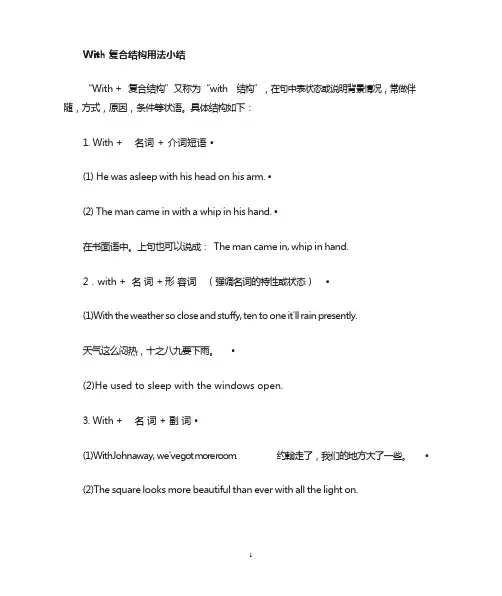
With 复合结构用法小结“With + 复合结构”又称为“with结构”,在句中表状态或说明背景情况,常做伴随,方式,原因,条件等状语。
具体结构如下:1. With + 名词 + 介词短语•(1)He was asleep with his head on his arm. •(2)The man came in with a whip in his hand. •在书面语中。
上句也可以说成: The man came in, whip in hand.2.with + 名词 + 形容词(强调名词的特性或状态)•(1)With the weather so close and stuffy, ten to one it'll rain presently.天气这么闷热,十之八九要下雨。
•(2)He used to sleep with the windows open.3.With + 名词 + 副词•(1)WithJohnaway, we've g ot more ro o m.约翰走了,我们的地方大了一些。
•(2)The square looks more beautiful than ever with all the light on.4.With + 名词 + -ed 分词(强调名词是 -ed 分词动作的承受者或动作已经发生)•(1)With this problem solved, neopenicillin 1 is now in regular production.随着这个问题的解决,新霉素一号现在已正式生产。
•(2)All the afternoon he worked with the door locked.5.with + 名词 + -ing 分词(强调名词是 -ing 分词的动作的发出者或某动作,状态正在进行)•(1)I won’t be able to go on holiday with my mother being ill. •(2)He felt more uneasy with the whole class staring at him. •(3)With the field leveled and irrigation channels controlling the volume of water( 水量), no such problem arose again.6.with + 名词 + to do (不定式动作尚未发生)•(1)So in the afternoon, with nothing to do, I went on a round of the bookshops.由于下午无事可做,我就去书店转了转。


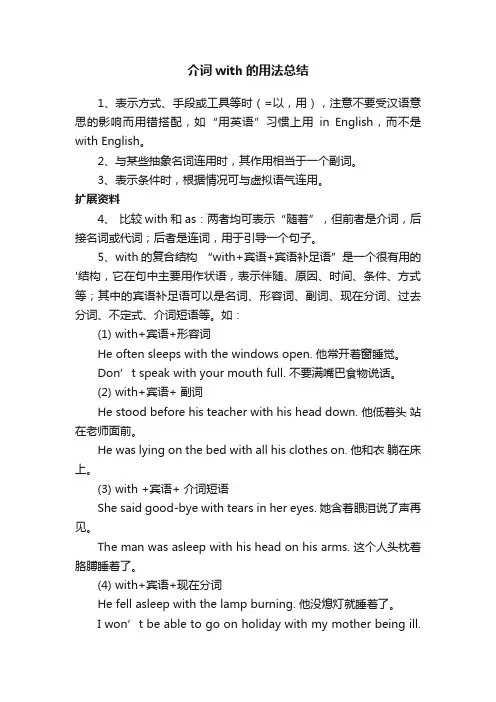
介词with的用法总结1、表示方式、手段或工具等时(=以,用),注意不要受汉语意思的影响而用错搭配,如“用英语”习惯上用in English,而不是with English。
2、与某些抽象名词连用时,其作用相当于一个副词。
3、表示条件时,根据情况可与虚拟语气连用。
扩展资料4、比较with和as:两者均可表示“随着”,但前者是介词,后接名词或代词;后者是连词,用于引导一个句子。
5、with的复合结构“with+宾语+宾语补足语”是一个很有用的'结构,它在句中主要用作状语,表示伴随、原因、时间、条件、方式等;其中的宾语补足语可以是名词、形容词、副词、现在分词、过去分词、不定式、介词短语等。
如:(1) with+宾语+形容词He often sleeps with the windows open. 他常开着窗睡觉。
Don’t speak with your mouth full. 不要满嘴巴食物说话。
(2) with+宾语+ 副词He stood before his teacher with his head down. 他低着头站在老师面前。
He was lying on the bed with all his clothes on. 他和衣躺在床上。
(3) with +宾语+ 介词短语She said good-bye with tears in her eyes. 她含着眼泪说了声再见。
The man was asleep with his head on his arms. 这个人头枕着胳膊睡着了。
(4) with+宾语+现在分词He fell asleep with the lamp burning. 他没熄灯就睡着了。
I won’t be able to go on holiday with my mother being ill.因为妈妈有病, 我无法去度假。
(5) with +宾语+ 过去分词He sat there with his eyes closed. 他闭目坐在那儿。


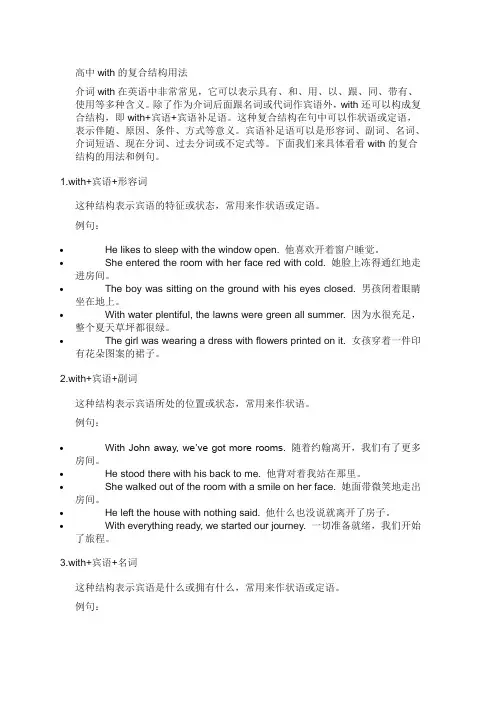
高中with的复合结构用法介词with在英语中非常常见,它可以表示具有、和、用、以、跟、同、带有、使用等多种含义。
除了作为介词后面跟名词或代词作宾语外,with还可以构成复合结构,即with+宾语+宾语补足语。
这种复合结构在句中可以作状语或定语,表示伴随、原因、条件、方式等意义。
宾语补足语可以是形容词、副词、名词、介词短语、现在分词、过去分词或不定式等。
下面我们来具体看看with的复合结构的用法和例句。
1.with+宾语+形容词这种结构表示宾语的特征或状态,常用来作状语或定语。
例句:•He likes to sleep with the window open. 他喜欢开着窗户睡觉。
•She entered the room with her face red with cold. 她脸上冻得通红地走进房间。
•The boy was sitting on the ground with his eyes closed. 男孩闭着眼睛坐在地上。
•With water plentiful, the lawns were green all summer. 因为水很充足,整个夏天草坪都很绿。
•The girl was wearing a dress with flowers printed on it. 女孩穿着一件印有花朵图案的裙子。
2.with+宾语+副词这种结构表示宾语所处的位置或状态,常用来作状语。
例句:•With John away, we’ve got more rooms. 随着约翰离开,我们有了更多房间。
•He stood there with his back to me. 他背对着我站在那里。
•She walked out of the room with a smile on her face. 她面带微笑地走出房间。
•He left the house with nothing said. 他什么也没说就离开了房子。
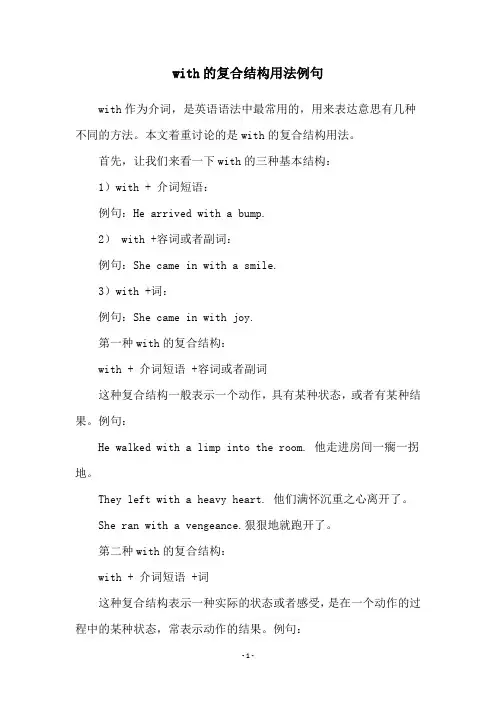
with的复合结构用法例句with作为介词,是英语语法中最常用的,用来表达意思有几种不同的方法。
本文着重讨论的是with的复合结构用法。
首先,让我们来看一下with的三种基本结构:1)with + 介词短语:例句:He arrived with a bump.2) with +容词或者副词:例句:She came in with a smile.3)with +词:例句:She came in with joy.第一种with的复合结构:with + 介词短语 +容词或者副词这种复合结构一般表示一个动作,具有某种状态,或者有某种结果。
例句:He walked with a limp into the room. 他走进房间一瘸一拐地。
They left with a heavy heart. 他们满怀沉重之心离开了。
She ran with a vengeance.狠狠地就跑开了。
第二种with的复合结构:with + 介词短语 +词这种复合结构表示一种实际的状态或者感受,是在一个动作的过程中的某种状态,常表示动作的结果。
例句:She hugged him with love.用爱拥抱了他。
The movie ended with sadness.影以悲伤结束。
He took his leave with regret. 他带着懊悔离去。
第三种with的复合结构:with +词 + 介词短语这种复合结构表示一种特定的情况或状况。
例句:His house was filled with decorations. 他的房子里满是装饰品。
The room was filled with smoke.间里充满烟雾。
The sky is filled with stars.空里满是星星。
以上是with的三种复合结构用法,它们都有丰富多彩的表达方式,在英语中经常用来表达某种额外的信息,有时候这些信息对我们的理解很重要。
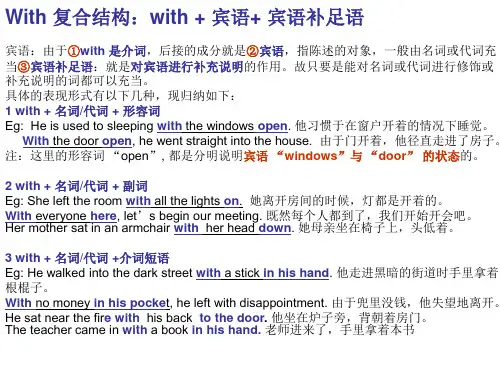

with复合结构用法归纳With 复合结构指的是“with+宾语+宾语补足语”结构,它是一个十分有用的结构,不仅教材中经常出现,考试中经常考到,而且它也是同学们写作时使句子变得“高级”的一个重要手段。
学会正确运用它,你会多方面受益。
with复合结构形式一:with+宾语+形容词He often sleeps with the windows open. 他常开着窗睡觉。
Don’t speak with your mouth full. 不要满嘴巴食物说话。
with复合结构形式二:with+宾语+副词He stood before his teacher with his head down. 他低着头站在老师面前。
He was lying on the bed with all his clothes on. 他和衣躺在床上。
with复合结构形式三:with+宾语+名词He died with his daughter yet a schoolgirl. 他去世时,女儿还是个小学生。
with复合结构形式四:with+宾语+介词短语She said good-bye with tears in her eyes. 她含着眼泪说了声再见。
He was asleep with his head on his arms. 他头枕着胳膊睡着了。
with复合结构形式五:with+宾语+现在分词(短语)He fell asleep with the lamp burning. 他没熄灯就睡着了。
I won’t be able to go on holiday with my mother being ill. 因为妈妈有病,我无法去度假。
with复合结构形式六:with+宾语+过去分词(短语)He sat there with his eyes closed. 他闭目坐在那儿。
All the afternoon he worked with the door locked. 整个下午他都锁着门在房里工作。
With复合结构的用法小结With复合结构的用法小结一、with结构的构成1. with或without-名词/代词+形容词;2. with或without-名词/代词+副词;3. with或without-名词/代词+介词短语;4. with或without-名词/代词+动词不定式;5. with或without-名词/代词+现在分词。
6. with或without-名词/代词+过去分词二、with结构的用法在句子中with结构多数充当状语,表示行为方式,伴随情况、时间、原因或条件。
1. She came into the room,with her nose red because of cold.(with+名词+形容词,作伴随状语)2. With the meal over ,we all went home.(with+名词+副词,作时间状语)3.The teacher entered the classroom with a book in his hand.(with+名词+介词短语,作伴随状语。
)4.He could not finish it without me to help him.(without+名词+不定式,作条件状语)5.She fell asleep with the light burning.(with+名词+现在分词,作伴随状语)6.Without anything left in the cupboard,she went out to get something to eat.(without+代词+过去分词,作为原因状语)With结构在句中也可以作定语。
例如:1.I like eating the mooncakes with eggs.2.From space the earth looks like a huge water-covered globe with a few patches of land sticking out above the water.3.A little boy with two of his front teeth missing ran into thehouse.1. with结构在句子中的位置:with 结构在句中作状语,表示时间、条件、原因时一般放在句子前面,并用逗号与句子分开;表示方式和伴随状况时一般放在句子后面,不用逗号分开。
With 复合结构用法小结“With + 复合结构”又称为“with结构”,在句中表状态或说明背景情况,常做伴随,方式,原因,条件等状语。
具体结构如下:1. With +名词+ 介词短语•(1) He was asleep with his head on his arm. •(2) The man came in with a whip in his hand. •在书面语中。
上句也可以说成:The man came in, whip in hand.2.with + 名词+ 形容词(强调名词的特性或状态)•(1)With the weather so close and stuffy, ten to one it'll rain presently.天气这么闷热,十之八九要下雨。
•(2)He used to sleep with the windows open.3. With +名词+ 副词•(1)With John away, we've got more room. 约翰走了,我们的地方大了一些。
•(2)The square looks more beautiful than ever with all the light on.4. With + 名词+ -ed 分词(强调名词是-ed分词动作的承受者或动作已经发生)•(1)With this problem solved, neopenicillin 1 is now in regular production.随着这个问题的解决,新霉素一号现在已正式生产。
•(2)All the afternoon he worked with the door locked.5. with + 名词+ -ing分词(强调名词是-ing分词的动作的发出者或某动作,状态正在进行)•(1)I won’t be able to go on holiday with my mother being ill. •(2)He felt more uneasy with the whole class staring at him. •(3)With the field leveled and irrigation channels controlling the volume of water(水量), no such problem arose again.6. with + 名词+ to do (不定式动作尚未发生)•(1)So in the afternoon, with nothing to do, I went on a round of the bookshops.由于下午无事可做,我就去书店转了转。
一、with的复合结构本结构在试卷上出现的频率非常高,学好这个结构我们能准确地进行答题、能更好地欣赏句子,同时也能让我们的书面表达出彩。
with复合结构常有以下结构:1. with + 宾语 + doingWith so many people communicating in English now, I find it very necessary to master it.现在有那么多的人用英语交流,我发现掌握英语很有必要。
2. with + 宾语 + doneWith my room cleaned, I went to bed.房间打扫了我就上床睡觉了。
3. with + 宾语 + to doThis is my first book, with the second to come out next year.这是我的第一本书,第二本明年出版。
with + 宾语 + to be doneThis is my first book, with the second to be published next year.这是我的第一本书,第二本明年出版。
5. with + 宾语 + adj.a. They left the office in a hurry, with the door open.他们匆忙离开了办公室,门都开着。
b. He always sleeps with the windows halfopen .他总是把窗户半开着睡觉。
6. with + 宾语 + adv.With all the lights on, the city looks more beautiful.在所有灯光的照耀下,这座城市显得更漂亮。
7. with + 宾语 + prep.-phraseHe came in, with a basket on his back.他进来了,背上背着一个篮子。
解析:从上面的结构看1) 首先要区分开在什么情况下用分词,什么情况下用不定式:如果表示do动作已发生或者是经常性的就要用分词;如果do动作还没有发生就要用动词不定式。
with语句的复合结构使用方法总结本文总结了使用with语句中复合结构的方法。
1. with语句的基本用法with语句是Python中一种资源管理工具,用于简化打开文件、访问数据库等操作。
基本语法如下:with 资源 as 变量:使用资源进行操作2. 使用with语句的复合结构在实际应用中,我们经常需要同时使用多个资源,这时可以使用with语句的复合结构,以提高代码的可读性和简洁性。
2.1 多个资源打开使用with语句的复合结构,可以同时打开多个资源,在退出时自动关闭这些资源。
例如,同时打开文件和数据库连接:with open('file.txt', 'r') as file, connect('database') as db:使用文件和数据库进行操作2.2 自定义资源管理器我们也可以自定义资源管理器,实现一些特定的操作。
例如,自定义一个数据库连接管理器:class DatabaseConnection:def __enter__(self):self.connect()def __exit__(self, exc_type, exc_val, exc_tb):self.disconnect()def connect(self):连接数据库的操作def disconnect(self):断开数据库连接的操作with DatabaseConnection() as db:使用数据库进行操作通过自定义资源管理器,我们可以在进入和退出时执行一些特定操作,如连接和断开数据库。
3. 注意事项使用with语句的复合结构时,需要注意以下几点:- 确保资源定义的顺序和使用的顺序一致,避免出现错误的使用情况。
- 每个资源都需要实现__enter__()和__exit__()方法,以确保正确的资源管理。
- 需要确保资源在退出时被正确地关闭或释放,以避免资源泄漏。
通过合理使用with语句的复合结构,可以提高代码的可维护性和可读性,同时减少资源管理的工作量。
1 With 的复合结构(with+ 复合宾语)with+ 复合宾语结构常作原因状语、伴随状语、定语等。
With + 名词/代词+名词With + 名词/代词+形容词With + 名词/代词+副词With + 名词/代词+介词短语With + 名词/代词+不定式(to do/ to be done 表示动作将要做, 若句中主语发出动作,用to do , 若句中主语不发出这一动作,则用to be doneWith + 名词/代词+现在分词(doing/ being done 表示动作与谓语动词同时进行,若是with 后的名词/代词发出动作,即所谓的主动,则用doing ; 若是被动,则用being done )With + 名词/代词+过去分词(动作已结束,动词与前面名词/代词的关系是被动) He left home, with his wife a hopeless soul.She used to sleep with the windows open.She used to sleep with the light on.She came in, with a book in her hand.With all the work to do, I don’t know if I’ll have time to go out.With the boy leading us, we soon found the house.With the house being painted, we can’t move in.With everything I needed bought, I left the shop.2 独立主格结构一般来说,我们把With 复合结构中的with 去掉,就成了独立主格结构了。
如:She slept, the windows open.The prisoner stood there, his hands raised. ( 可以这样理解:hand 是被举起的,表示被动和完成)Time permitting, We ‘ll go for a picnic.(time和permit 是主动关系)She came in, book in hand. (注: book 和hand 之前不加任何代词或冠词,这与with 复合结构不同)还有不同的是,独立主格中出现了beingIt being a fine day, we decided to go swimming.There being no bus, I had to go home on foot.这两句话中的being 是由动词be 变来的,可以这样想:独立主格也是状语,所以不能使用谓语动词。